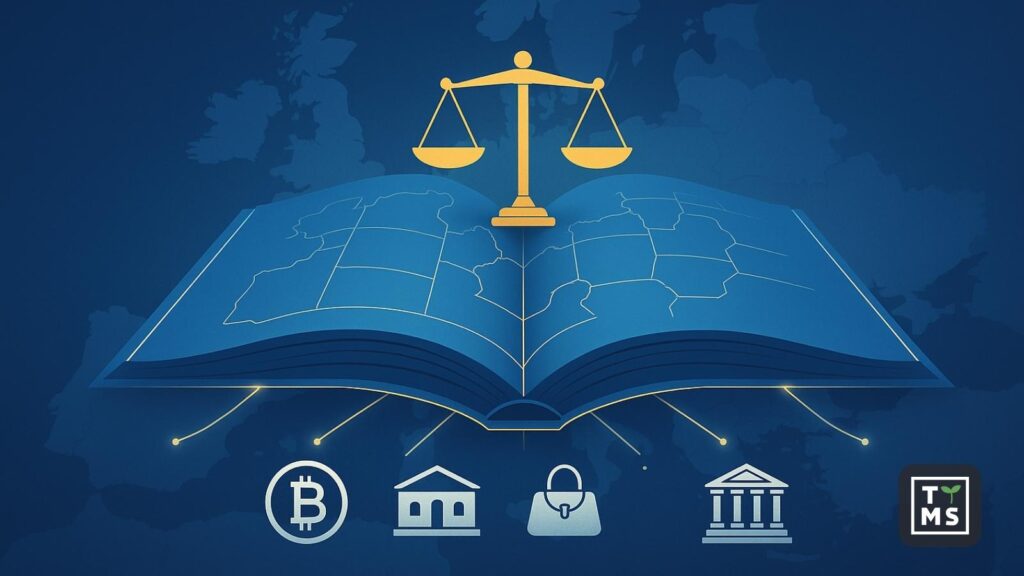Unia Europejska konsekwentnie zaostrza przepisy dotyczące przeciwdziałania praniu pieniędzy (AML). Szósta Dyrektywa AML (6AMLD) jest już w mocy, a ambitne nowe Rozporządzenie AML UE zostało przyjęte i zacznie obowiązywać od lipca 2027 r. Razem te regulacje wprowadzają istotne zmiany dla firm we wszystkich sektorach. Poniżej przedstawiamy kluczowe punkty oraz praktyczne implikacje 6AMLD i nowego Rozporządzenia AML dla przedsiębiorstw działających w UE.
Zrozumieć 6AMLD: Nowy poziom egzekwowania prawa i odpowiedzialności
6AMLD zostało wprowadzone, aby wzmocnić i ujednolicić przepisy AML w państwach członkowskich UE. Musiało zostać transponowane do prawa krajowego do grudnia 2020 r., a przedsiębiorstwa były zobowiązane do pełnej zgodności od czerwca 2021 r. W przeciwieństwie do wcześniejszych dyrektyw, 6AMLD kładzie duży nacisk na zamykanie luk prawnych i zapewnienie, że przestępcy (oraz współdziałające z nimi firmy) poniosą surowsze konsekwencje. Najważniejsze zmiany obejmują:
- Ściganie przestępstw transgranicznych: 6AMLD ułatwia ściganie przypadków prania pieniędzy obejmujących wiele krajów. Zobowiązuje państwa UE do skuteczniejszej współpracy i pozwala na ściganie przestępstw popełnionych w różnych jurysdykcjach w jednym państwie członkowskim. Co istotne, w odniesieniu do poważnych przestępstw (np. terroryzm, handel ludźmi, przestępczość zorganizowana), państwa muszą traktować je jako przestępstwa bazowe prania pieniędzy nawet jeśli dane zachowanie nie jest nielegalne w miejscu jego popełnienia. Likwidacja tej „zasady podwójnej karalności” oznacza, że sprawcy nie mogą już ukrywać się za różnicami w systemach prawnych poszczególnych krajów.
- Ujednolicone przestępstwa bazowe: Dyrektywa wprowadza jednolitą listę 22 przestępstw bazowych, które stanowią pranie pieniędzy w całej UE. Dodano nowe kategorie, takie jak przestępstwa przeciwko środowisku, cyberprzestępczość czy insider trading, aby odzwierciedlić współczesne zagrożenia. Firmy muszą upewnić się, że ich programy zgodności są w stanie wykrywać transakcje powiązane z każdą z tych kategorii, ponieważ zakres ryzyka został znacząco poszerzony.
- Odpowiedzialność karna podmiotów zbiorowych: Kluczową zmianą jest możliwość pociągnięcia do odpowiedzialności karnej osób prawnych (firm i spółek osobowych) za pranie pieniędzy. Jeśli przedsiębiorstwo nie zapobiegnie temu, że osoba sprawująca faktyczne kierownictwo (np. menedżer lub członek zarządu) zaangażuje się w proceder, sama firma może zostać oskarżona. Liderzy biznesu i osoby na stanowiskach decyzyjnych mogą być także osobiście odpowiedzialni za zaniedbania w nadzorze lub brak odpowiednich procedur. W praktyce to na firmie spoczywa teraz ciężar dowodu, że podjęła wystarczające kroki, by zapobiec praniu pieniędzy. To znacznie podnosi wymagania wobec zarządów w zakresie skutecznych mechanizmów AML.
- Surowsze kary: 6AMLD nakazuje zaostrzenie sankcji za pranie pieniędzy. Państwa UE muszą wprowadzić minimalną karę czterech lat więzienia dla osób skazanych (wcześniej minimum wynosiło rok). Firmy skazane za udział w procederze mogą być obciążone wysokimi grzywnami, a także sankcjami takimi jak zakaz prowadzenia działalności, wykluczenie z finansowania publicznego czy nawet trwałe zamknięcie. Celem jest zapewnienie, że naruszenia AML spotkają się z „skutecznymi, proporcjonalnymi i odstraszającymi” sankcjami.
- Kryminalizacja pomocnictwa i podżegania: Dyrektywa rozszerza zakres przestępstw AML o pomocnictwo, podżeganie, nakłanianie i usiłowanie prania pieniędzy. Tzw. podmioty ułatwiające proceder – wszyscy, którzy pomagają lub próbują pomóc w praniu pieniędzy – mogą być teraz ścigani jak sprawcy, nawet jeśli sami nie odnieśli żadnych korzyści finansowych. Dla firm oznacza to, że pracownicy, partnerzy czy podwykonawcy, którzy choćby pośrednio wspierają klientów w nielegalnych działaniach, narażają siebie i przedsiębiorstwo na odpowiedzialność.

Praktyczne konsekwencje 6AMLD: Ponieważ 6AMLD jest już w mocy, firmy musiały znacząco zaostrzyć swoje programy AML. Rozszerzenie odpowiedzialności karnej na przedsiębiorstwa i menedżerów sprawiło, że stało się niezbędne szybkie identyfikowanie i eliminowanie luk w zgodności. Firmy powinny aktualizować polityki AML/CFT, procedury i szkolenia, aby uwzględniały rozszerzoną listę przestępstw bazowych oraz nowe kategorie. Mechanizmy nadzoru wewnętrznego (np. audyty, zatwierdzenia kierownicze) wymagają wzmocnienia, by sprostać wyższym wymaganiom. Wiele firm wdraża rozwiązania RegTech, aby skuteczniej wykrywać podejrzane działania. (Na przykład korzystanie z zaawansowanego oprogramowania do zgodności, takiego jak AML Track, może pomóc w bieżącym monitorowaniu transakcji i beneficjentów rzeczywistych, zapewniając, że żadne sygnały ostrzegawcze nie zostaną pominięte.) Ogólny przekaz 6AMLD jest jasny: zgodność z AML to już nie tylko formalność, ale kluczowy element odpowiedzialności korporacyjnej.
Nowe Rozporządzenie AML UE: Jeden kodeks dla wszystkich państw członkowskich
Choć 6AMLD było ostatnią dyrektywą AML, zostało już uzupełnione przez ambitne Rozporządzenie AML UE, przyjęte w 2024 r. W tym samym roku UE zatwierdziła pakiet reform AML, obejmujący rozporządzenie, które zacznie obowiązywać od lipca 2027 r. W przeciwieństwie do dyrektyw, rozporządzenie jest stosowane bezpośrednio we wszystkich państwach członkowskich, tworząc jednolity kodeks AML. Rozporządzenie (UE) 2024/1624, przyjęte w 2024 r. i obowiązujące od lipca 2027 r., zastąpi dotychczasowe 4. i 5. Dyrektywę AML oraz ich krajowe warianty.
Co wprowadza nowe Rozporządzenie AML? W istocie podnosi ono i ujednolica wymagania AML w całej Europie, zamyka luki i zapewnia spójność. Kluczowe zmiany, na które firmy powinny się przygotować, to:
- Bardziej rygorystyczne obowiązki CDD: Firmy będą musiały prowadzić wzmocnioną identyfikację i ciągły monitoring beneficjentów rzeczywistych swoich klientów i partnerów biznesowych. Oznacza to konieczność posiadania aktualnych danych o tym, kto faktycznie posiada lub kontroluje spółki-klientów, oraz monitorowania wszelkich zmian. Ponadto raportowanie podejrzanych działań będzie musiało odbywać się szybciej – regulatorzy narzucają limit pięciu dni roboczych na odpowiedź wobec zapytań jednostek FIU. W praktyce oznacza to konieczność przyspieszenia dochodzeń wewnętrznych i raportowania transakcji podejrzanych. Nawet transakcje kryptowalutowe zostaną objęte surowszym nadzorem: rozporządzenie wprost rozszerza wymogi CDD na dostawców usług krypto, co oznacza, że giełdy i platformy kryptowalutowe będą musiały stosować te same rygorystyczne standardy, co banki.
- Limity transakcji gotówkowych: Duże płatności gotówkowe zostaną ograniczone w całej UE, aby zmniejszyć ryzyko prania pieniędzy za pomocą gotówki. Rozporządzenie wprowadza ogólnounijny limit 10 000 € dla transakcji gotówkowych w biznesie. Każda płatność powyżej tej kwoty będzie nielegalna, a państwa członkowskie będą mogły stosować jeszcze niższe limity krajowe. Ponadto, w przypadku transakcji na kwotę 3 000 € lub więcej, przedsiębiorstwa będą musiały zweryfikować tożsamość klienta i zachować dokumentację. Oznacza to, że branże związane z dobrami luksusowymi (np. dealerzy samochodów, jubilerzy, galerie sztuki) będą musiały wprowadzić ścisłe procedury przyjmowania gotówki. Firmy powinny zaktualizować swoje polityki płatności i przeszkolić pracowników, aby egzekwować nowe limity.
- Rozszerzenie zakresu podmiotów objętych obowiązkami: Nowe przepisy obejmują szersze grono firm. Rozporządzenie AML poszerza definicję „instytucji obowiązanych” o sektory i działalności wcześniej poza reżimem AML. Do systemu zostały wprost dodane m.in. dostawcy usług krypto, platformy crowdfundingowe, pośrednicy nieruchomości i sztuki, kluby piłkarskie i agenci sportowi, a także handlarze dobrami luksusowymi (np. metale i kamienie szlachetne). Niektóre profesje, jak prawnicy czy księgowi, były już objęte wcześniejszymi dyrektywami; teraz sieć regulacji jest jeszcze szersza. Choć w pewnych przypadkach możliwe są wyjątki dla działalności o bardzo niskim ryzyku, generalnie więcej firm niż kiedykolwiek wcześniej musi wdrożyć programy AML. Jeśli Twoja firma działa w jednej z nowo objętych branż, konieczne będzie przygotowanie procedur weryfikacji klienta, prowadzenia dokumentacji i raportowania podejrzanych transakcji. Nawet przedsiębiorstwa formalnie nieobjęte mogą zwrócić uwagę organów, jeśli dokonują dużych czy nietypowych transakcji.
- Ujednolicone zasady dotyczące beneficjentów rzeczywistych: Nowe przepisy standaryzują sposób identyfikacji i zgłaszania beneficjentów rzeczywistych (osób faktycznie posiadających lub kontrolujących dany podmiot). W całej UE beneficjent rzeczywisty będzie definiowany jako każdy, kto posiada 25% lub więcej udziałów lub praw głosu w spółce bądź sprawuje nad nią kontrolę w inny sposób. Wcześniej część krajów stosowała nieco inne progi (np. „więcej niż 25%”); nowa zasada 25% jest jasna i jednolita. W sektorach wysokiego ryzyka Komisja Europejska może obniżyć próg do 15%, co wymusi ujawnianie właścicieli już przy mniejszych pakietach. Dla firm oznacza to konieczność skrupulatnego gromadzenia i aktualizowania danych o właścicielach klientów. Co więcej, organy będą aktywnie weryfikować te informacje: zgodnie z równoległą 6. Dyrektywą AML rejestry będą kontrolowane i łączone w całej Europie. Powstanie też scentralizowany punkt dostępu na poziomie UE, co ułatwi szybkie pozyskiwanie danych ponad granicami. W praktyce ukrywanie prawdziwych właścicieli za skomplikowanymi strukturami stanie się znacznie trudniejsze.
- Nowy Europejski Urząd AML (AMLA): Dużą zmianą instytucjonalną jest utworzenie Europejskiego Urzędu AML (AMLA) z siedzibą we Frankfurcie. Od 2025 r. AMLA zacznie budować swoje struktury, a w latach 2026–2027 ma być w pełni operacyjny. Agencja będzie miała bezpośrednie uprawnienia nadzorcze wobec wybranych instytucji finansowych wysokiego ryzyka (do 40 największych banków i fintechów w UE) oraz będzie koordynować nadzór nad szerszym sektorem finansowym i niefinansowym. Dla większości firm wpływ AMLA będzie pośredni, lecz znaczący: urząd ustali ujednolicone standardy regulacyjne (poprzez wytyczne, standardy techniczne itp.) i dopilnuje, aby organy krajowe egzekwowały przepisy konsekwentnie. Jeśli nadzór krajowy będzie zbyt łagodny, AMLA będzie mogła interweniować. Oznacza to koniec ery „łagodnego nadzoru” AML w UE i wyrównanie zasad gry. Dla firm międzynarodowych to większa przewidywalność, ale i bardziej szczegółowa kontrola.

Praktyczne implikacje i kolejne kroki dla biznesu
Jednolity system zgodności w UE
Nowe Rozporządzenie AML stworzy bardziej spójne środowisko regulacyjne w całej Unii. Dla firm działających w wielu krajach to dobra wiadomość – zgodność zostanie uproszczona, a konieczność lawirowania między różnymi systemami krajowymi zniknie. Firmy będą mogły opracować jeden program AML ważny w całej UE, co ułatwi polityki i szkolenia.
Większa odpowiedzialność
Z drugiej strony, nowy system oznacza wzrost odpowiedzialności. Na mocy 6AMLD i nowego rozporządzenia organy nadzoru mają więcej narzędzi, a tolerancja dla zaniedbań będzie mniejsza. Zarządy i rady nadzorcze muszą traktować AML jako strategiczny priorytet – grozi im osobista odpowiedzialność za poważne zaniedbania. Koniec z „odhaczaniem obowiązków” – regulatorzy oczekują działań proaktywnych.
Nowe procedury i szkolenia
Firmy powinny już teraz aktualizować procedury AML, zamiast czekać do 2027 r. Dotyczy to m.in. zasad identyfikacji beneficjentów rzeczywistych, szkoleń dla pracowników czy polityk gotówkowych dostosowanych do limitu 10 000 €. Branże nowo objęte obowiązkami muszą zbudować cały system AML od podstaw – od oceny ryzyka, przez procedury weryfikacji klienta, po raportowanie do FIU.
Technologia w AML
Zakres monitorowania rośnie, dlatego ręczne procesy przestają wystarczać. Eksperci zachęcają firmy do inwestycji w narzędzia RegTech. Automatyzacja i analityka danych pomagają szybciej identyfikować podejrzane transakcje i anomalie. AML Track wspiera firmy w bieżącej weryfikacji klientów, monitorowaniu transakcji i raportowaniu – odciążając zespoły compliance.
Bądź krok przed regulatorem
Warto pamiętać, że organy nie czekają do 2027 r. – kierunek prawa UE już teraz oznacza surowsze kontrole. Wprost wskazuje się, że zaostrzone egzekwowanie obowiązków AML zacznie się wcześniej. Firmy powinny wykorzystać ten czas na audyty wewnętrzne i usuwanie słabości, zanim zrobią to regulatorzy.
Nowa era odpowiedzialności dla firm
Podsumowując, 6AMLD i nowe Rozporządzenie AML UE otwierają erę pełnej odpowiedzialności i jednolitych zasad. Firmy muszą przygotować się na większy zakres obowiązków i proaktywne działania. To także szansa na spójniejsze reguły i bezpieczniejsze środowisko biznesowe w całej Unii.
AML Track: wsparcie dla biznesu w nowej erze zgodności
Dostosowanie się do 6AMLD i nowego Rozporządzenia AML UE może być trudne, ale technologia może ten proces uprościć. AML Track to zaawansowana platforma zgodności – automatyzuje KYC, monitoruje transakcje w czasie rzeczywistym, sprawdza listy sankcyjne i tworzy raporty audytowe. Dzięki centralizacji procesów AML ogranicza ryzyko błędów i zapewnia zgodność z dynamicznie zmieniającymi się wymogami UE.

Jak 6AMLD różni się od wcześniejszych dyrektyw AML?
Jaki wpływ będzie miało Rozporządzenie AML UE w porównaniu z dyrektywami?
Dlaczego kwestia beneficjenta rzeczywistego jest tak istotna w nowych przepisach?
Beneficjent rzeczywisty znalazł się w centrum nowych regulacji, ponieważ to właśnie on często ukrywa się za skomplikowanymi strukturami korporacyjnymi, które mogą być wykorzystywane do prania pieniędzy lub finansowania terroryzmu. Przestępcy wykorzystują spółki fasadowe i wielopoziomowe układy właścicielskie, aby zamaskować prawdziwego właściciela środków lub aktywów. Nowe przepisy wprowadzają jednolitą definicję beneficjenta rzeczywistego w całej UE, określając go jako osobę posiadającą 25% lub więcej udziałów bądź praw głosu, a w sektorach wysokiego ryzyka próg ten może zostać obniżony do 15%. Oznacza to, że firmy muszą gromadzić i stale aktualizować dane o właścicielach klientów, a organy nadzoru będą aktywnie weryfikować te informacje w rejestrach połączonych na poziomie europejskim. Dzięki temu znacznie trudniej będzie ukrywać prawdziwych właścicieli za złożonymi strukturami, a przedsiębiorstwa muszą zapewnić pełną przejrzystość i dokładność danych, które przekazują regulatorom.
W jaki sposób AMLA zmieni krajobraz egzekwowania przepisów w Europie?
Co firmy powinny zrobić już teraz, aby przygotować się na nowe Rozporządzenie AML?
Przedsiębiorstwa nie powinny czekać do 2027 roku z dostosowaniem się do nowych regulacji, lecz rozpocząć przygotowania już teraz. Kluczowym krokiem jest przegląd i aktualizacja istniejących procedur AML, tak aby obejmowały one rozszerzone obowiązki w zakresie identyfikacji i monitorowania beneficjentów rzeczywistych oraz szybszego raportowania podejrzanych transakcji. Firmy powinny także wzmocnić szkolenia dla pracowników, aby potrafili rozpoznawać nowe kategorie przestępstw bazowych, w tym związane z cyberprzestępczością czy przestępstwami środowiskowymi. Konieczne jest również dostosowanie polityk przyjmowania gotówki do nowych limitów oraz, w przypadku nowo objętych branż, zbudowanie całego systemu AML od podstaw – od oceny ryzyka po raportowanie do jednostek FIU. Warto zainwestować w technologie wspierające zgodność, takie jak rozwiązania RegTech, które automatyzują monitoring i analizę danych. Podjęcie działań z wyprzedzeniem pozwoli nie tylko uniknąć sankcji, ale także zbudować przewagę konkurencyjną i wzmocnić zaufanie regulatorów oraz partnerów biznesowych.







